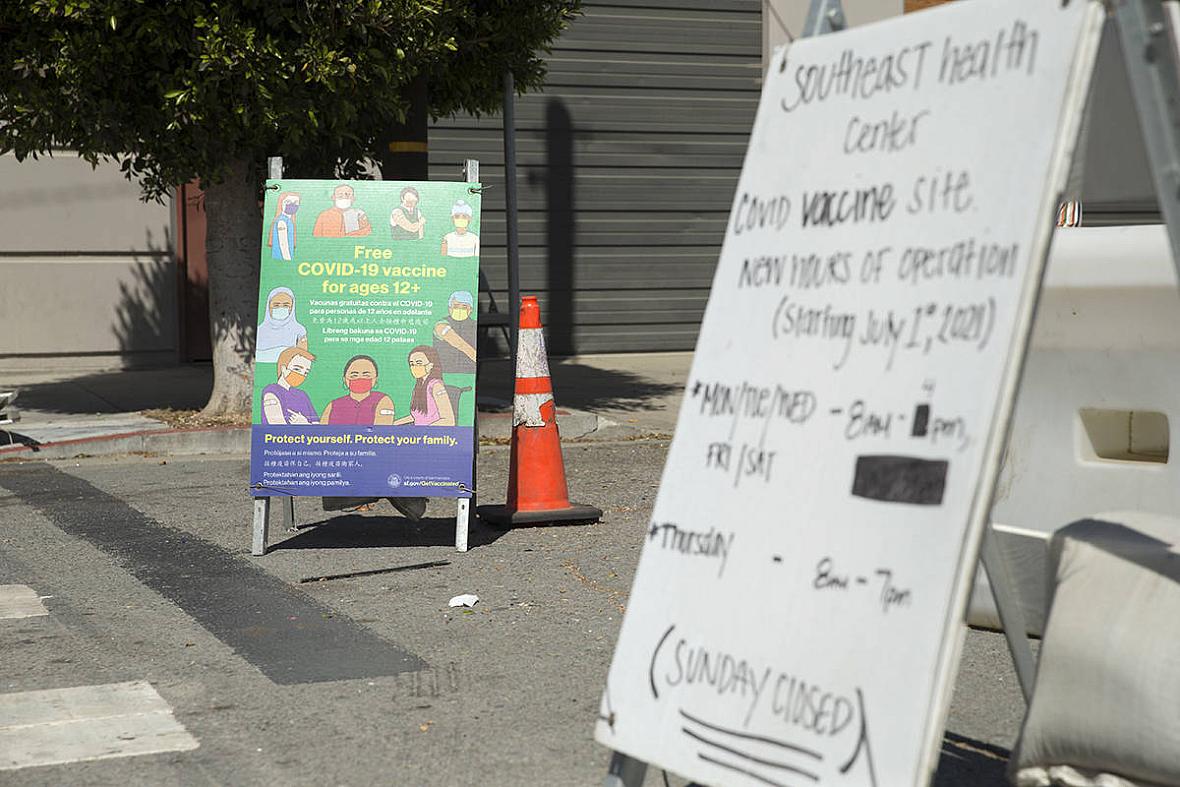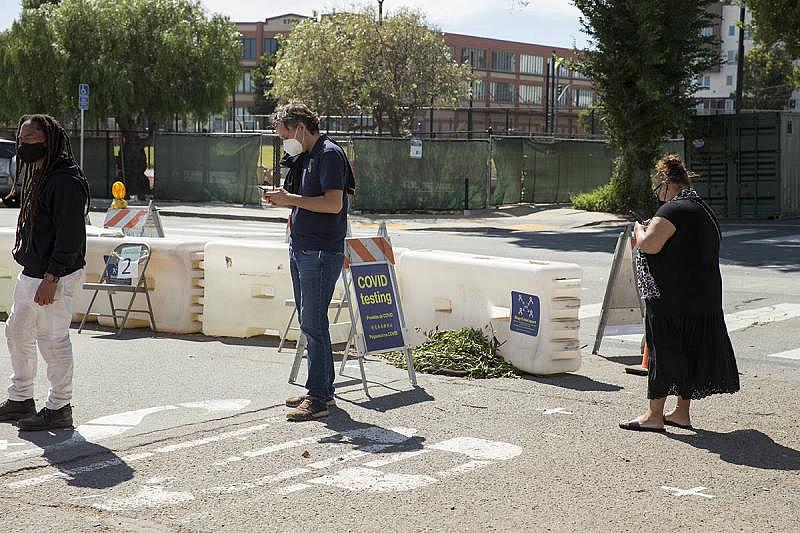Vaccines increase as Bayview-Hunters Point battles Delta surge
This story is part of a series produced by Carly Graf, a participant in the USC Annenberg Center for Health Journalism’s 2021 California Fellowship.
Her other stories include:
Is Golden Gate Park really for all San Franciscans?
Public transit fails its mission in the Bayview
How San Francisco’s Bayview neighborhood is battling toxic air
San Francisco’s Bayview district struggles to emerge from food desert

The Southeast Health Center COVID-19 testing and vaccine site in the Bayview District offers free services
(Kevin N. Hume/The Examiner)
Simone Ippoliti helps run COVID-19 vaccine and testing at four affordable housing sites in the Bayview-Hunters Point neighborhood. Demand for testing has remained fairly stable, but the number of people wanting shots has lulled.
That’s starting to change.
“Today was the first time where I saw a resurgence in people wanting vaccines who had been eligible for a long time,” she said on Aug. 20. Ippoliti is site director for the Bayview Child Health Center, part of local nonprofit South of Market Health Center. “I think a lot of that is due to the return to school and new vaccination mandates.”
Amid a citywide surge in coronavirus cases driven by the delta variant, Bayview-Hunters Point is facing an especially grave spike, one that community health care providers likened to the earliest stages of the pandemic.
From left, William Palmer, William Beecher and Joline Valenzuela visited the Southeast Health Center in the Bayview District on Aug. 2. (Kevin N. Hume/The Examiner)
Between June 20 and Aug. 19, it reported the highest case rate of any neighborhood in The City with 195 cases per 10,000 residents with at least 741 new cases confirmed, Department of Public Health data shows.
By comparison, Castro/Upper Market and South of Market follow behind with case rates of 167 and 144 cases per 10,000 residents, respectively. The Mission, a higher density neighborhood, has had 669 cases over the same two-month period.
“I feel like we’re right back to the beginning in that we are just seeing a massive increase in cases,” Ippoliti said. “And the part that’s really sad is we’re seeing it mostly amongst our youth and those who haven’t been vaccinated.”
Case counts grow quickly as it’s not uncommon to see entire households test positive for the virus. Many Bayview-Hunters Point residents live with multiple generations under the same roof, both for cultural reasons and because of San Francisco’s inadequate supply of below market-rate housing.
Additionally, the neighborhood is home to many people with jobs that can’t be conducted remotely, exposing them more readily to the highly transmissible variant.
These realities have held true for the entire pandemic. This same ZIP code — 94124 — has the highest case rate of any neighborhood in The City dating to March 2, 2020. Its total case number of 4,709 is second only to the Mission District, which has had 4,842 cases, according to DPH.
What has changed, though, is the dawn of an effective vaccine that significantly reduces community spread of the virus or the chances for severe symptoms and hospitalization.
About 78 percent of San Franciscans have received at least one dose of the vaccine, and about 72 percent are fully inoculated, according to the latest health agency data.
Bayview-Hunters Point is one of the most vaccinated parts of The City. Roughly 85 percent of residents have at least one dose. Nearly 14 percent of those shots were administered by DPH, more than any other neighborhood.
Local health officials say these figures show the efficacy of The City’s efforts to prioritize the most vulnerable and demonstrate its commitment to outreach in the Bayview-Hunters Point.
San Francisco opened up two free vaccination sites — one at 1800 Oakdale Ave. and another at Southeast Health Center — and rolled out mobile vaccine options. Residents in that ZIP code were some of the first to become eligible for the vaccine after health care workers and seniors.
“From the outset of the pandemic, San Francisco has been a national model in terms of outreach to communities that have been hardest hit by COVID-19,” the Department of Health said in a statement. “We have engaged trusted community partners to ensure our vaccination outreach results in more people getting vaccinated in these hard-hit communities. Our focus on racial equity in vaccine distribution has been successful; a higher proportion of the DPH-administered vaccinations have gone to people of color.”
But there remain pockets of people who have yet to get vaccinated. It’s among those groups that the delta variant continues to spread largely unabated in the area.
Some people simply have a hard time getting to vaccination sites; or limited hours don’t coincide with work and childcare schedules. Others have a deeper mistrust of the idea.
To understand why, take a look at history, say community health care workers, responding to people frustrated by vaccine hesitancy.
The harrowing legacy of the Tuskegee Syphilis Study, a federally funded effort that left droves of Black men untreated for the disease without consent, remains front of mind for many seniors living in communities of color.
Then there’s the Bayview’s swaths of young people, many of whom feel disenfranchised or misled by traditional health care systems. Also, the neighborhood has a sizable immigrant population that may struggle with language barriers, fear of discrimination or stubborn bureaucracy.
“With vaccines, all these issues come to a head,” said Brittney Doyle, executive director of the nonprofit WISE Health. “A lot of the efforts that are starting to take place need to be rooted in healing, truth and reconciliation in order to build that trust and then get people vaccinated.”
An example is the collaboration between Umoja Health and UCSF. It brings pop-up clinics to Black neighborhoods to offer testing, vaccines and education as well as deploys health care workers already well-known in the community to knock on doors and answer questions around COVID-19 prevention efforts.
This kind of community-led partnership will most likely reach those who have yet to be vaccinated, local grassroots leaders say. They note that top-down strategies often miss real experiences that inform people’s understanding of health care and other systems.
Many local advocates say the pandemic has shown that most success occurs when community-based organizations lead the way, bolstered by city resources. They also point out there’s been progress made, and more of such partnerships are emerging in Bayview-Hunters Point.
Facing down this latest surge, considering the trauma of the last year-and-a-half, is taking its toll on the community. The journey to rebuild trust will be long.
“It was one thing to look forward and say, ‘We just need to get through this one thing, and there’s light at the end of the tunnel,’” Ippoliti said. “With this resurgence of cases, what we’re realizing is that the light is a lot further and a lot dimmer than we had previously hoped.”
Carly Graf wrote this story while participating in the USC Annenberg Center for Health Journalism’s 2021 California Fellowship.
[This story was originally published by the SF Examiner.]
